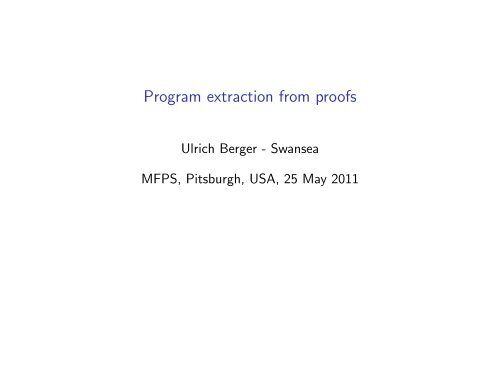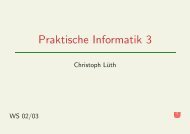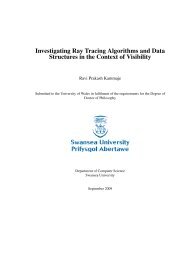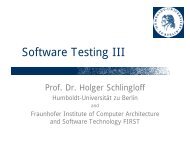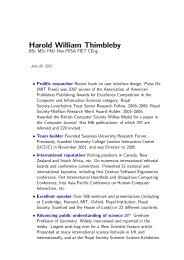Program extraction from proofs
Program extraction from proofs
Program extraction from proofs
You also want an ePaper? Increase the reach of your titles
YUMPU automatically turns print PDFs into web optimized ePapers that Google loves.
<strong>Program</strong> <strong>extraction</strong> <strong>from</strong> <strong>proofs</strong><br />
Ulrich Berger - Swansea<br />
MFPS, Pitsburgh, USA, 25 May 2011
Outline<br />
Proofs as programs<br />
<strong>Program</strong> <strong>extraction</strong> in computable analysis<br />
Towards memoized functionals in higher types<br />
Conclusion
Proofs as programs<br />
<strong>Program</strong> <strong>extraction</strong> in computable analysis<br />
Towards memoized functionals in higher types<br />
Conclusion
The Curry-Howard correspondence<br />
(or Brouwer-Heyting-Kolmogorov interpretation)<br />
Formulas correspond to data types<br />
Proofs correspond to programs<br />
A ∨ B<br />
A ∧ B<br />
A → B<br />
∃x A<br />
∀x A<br />
disjoint sum<br />
cartesian product<br />
function space<br />
cartesian product<br />
function space<br />
A proof of a formula A correponts to a program constructing an<br />
element of A.<br />
◮ What is a function?<br />
◮ What if the quantified x ranges over abstract objects?<br />
◮ How do we interpret logical axioms, e.g. A ∨ ¬A?<br />
◮ How do we interpret maths axioms, e.g. induction, choice?<br />
◮ Why is it interesting and useful?
Why Curry-Howard is interesting and useful<br />
Foundations<br />
Constructive foundation of Mathematics (Brouwer, Heyting,<br />
Kolmogorov, Gödel, Kleene, Kreisel, Martin-Löf). Properties of<br />
logical and mathematical systems (Realizability ⇒ existence and<br />
disjunction property; Dialectica Interpretation ⇒ consistency)<br />
<strong>Program</strong>ming<br />
<strong>Program</strong> <strong>extraction</strong> (Minlog, Coq, Isabelle, Agda). In Minlog,<br />
realizability is used to automatically extract <strong>from</strong> a proof a<br />
program and its correctness proof (⇒ Monika’s talk).<br />
Mathematics<br />
Approximation-, fixpoint- and ergodic-theory (Kohlenbach, DI).<br />
The study of function spaces has led to new developments in<br />
computability theory, topology, domain theory. The problem of<br />
C-H interpreting classical choice axioms has led to new recursion<br />
principles such as bar recursion and products of selection functions<br />
(⇒ Martin’s and Paulo’s talks).
What is a function and when is it a proof of an implication?<br />
BHK-interpretation: A proof of A → B is a function f mapping<br />
<strong>proofs</strong> of A to <strong>proofs</strong> of B.<br />
◮ f should be computable. What does this mean if A itself<br />
consists of functions? (⇒ computability in higher types)<br />
◮ Don’t we need a proof that f does it’s job? (circularity!)
Realizing an implication<br />
Realizability (Kleene, Kreisel)<br />
f r (A → B) ≡ ∀a (a r A → f (a) r B)<br />
Dialectica Interpretation (Gödel)<br />
(f , g)(A → B) ≡ ∀a, v (ag(a, v)A → f (a)vB)<br />
where aA ≡ ∀u (auA) and bB ≡ ∀v (bvB) are purely universal<br />
formulas.<br />
The idea is that for the conclusion, f (a)vB, the premise, ∀u (auA)<br />
is used for finitely many u only (continuity argument), in fact, a<br />
single u = g(a, v) suffices.<br />
Both interpretations extract <strong>from</strong> a proof of A a term M and a<br />
proof of M r A (Soundness Theorem).<br />
In the DI the proof of M r A takes place in a quantifier free system!
Realizing quantifiers<br />
(x, a) r ∃x A(x) ≡ a r A(x)<br />
f r ∀x A(x) ≡ ∀x (f (x) r A(x))<br />
x may range over abstract object (reals, real functions, . . . ).<br />
This seems to require a realizing programming language with data<br />
types for such abstract objects.<br />
Alternative: uniform realization of quantifiers<br />
a r ∃x A(x) ≡ ∃x (a r A(x))<br />
a r ∀x A(x) ≡ ∀x (a r A(x))<br />
For concrete objects we may relativize the quantifiers:<br />
∀x (N(x) → ∃y (N(y) ∧ (x = 2y ∨ x = 2y + 1)))<br />
where N is defined such that n r N(x) means that n is a<br />
representation of the natural number x.<br />
The extracted program computes integer division by 2.
<strong>Program</strong> <strong>extraction</strong> and the law of excluded middle<br />
Realizing, say, ∀x (N(x) → A(x) ∨ ¬A(x)) would mean to<br />
construct a program computing for every (representation of) a<br />
natural number x a realizer of A(x) or a realizer or ¬A(x). This is<br />
impossible, in general.<br />
But, one can eliminate LEM in <strong>proofs</strong> of formulas of the form<br />
∀x (N(x) → ∃y (N(y) ∧ A 0 (x, y))<br />
where A 0 (x, y) is decidable, using Gödel’s negative translation and<br />
the Friedman/Dragalin A-translation (⇒ Monika’s talk).
Other approaches to program <strong>extraction</strong> <strong>from</strong> classical<br />
<strong>proofs</strong><br />
◮ ɛ-substitution calculus (Hilbert).<br />
◮ Interpretation of ¬¬A → A by continuations (Felleisen).<br />
◮ Direct computational interpretation of classical sequent<br />
calculus (λµ-calculus, Parigot).<br />
◮ Interpretation of restricted forms of LEM by learning based<br />
realizability (Berardi, Aschieri)<br />
◮ Realizability interpretation of classical systms via stacks and<br />
processes (Krivine).
Interpreting induction<br />
Induction on natural numbers<br />
A(0) ∧ ∀x (A(x) → A(x + 1)) → ∀x (N(x) → A(x))<br />
is a special case of induction on an inductively defined predicate:<br />
Set Φ(X ) := {0} ∪ {x + 1 | x ∈ X }, then N = µΦ = µX .Φ(X )<br />
In general, one has for a monotone predicate transformer Φ an<br />
induction schema for its least fixed point µΦ:<br />
Φ(P) ⊆ P → µΦ ⊆ P<br />
The data type associated with µΦ is the initial algebra<br />
In ϕ : ϕ(µϕ) → µϕ of a functor ϕ derived <strong>from</strong> Φ. The induction<br />
scheme is realized by the iterator It ϕ that iterates any “step<br />
function” (i.e. ϕ-algebra) f : ϕ(α) → α to an algebra morphism<br />
It ϕ (f ) : µϕ → α with computation rule (i.e. morphism equation)<br />
It ϕ (f ) In ϕ (m) = f (map ϕ (It ϕ (f ))(m))
Example: Natural numbers<br />
Recall N = µΦ where<br />
Φ(X ) = {0} ∪ {x + 1 | x ∈ X }<br />
= {y | y = 0 ∨ ∃x (y = x + 1 ∧ x ∈ X )}<br />
The functor associated with Φ is obtained by removing all<br />
first-order parts <strong>from</strong> Φ: ϕ(α) = 1 + α The initial algebra<br />
In ϕ : ϕ(µϕ) → µϕ is the familiar structure of unary natural<br />
numbers N := µϕ generated by zero and successor.<br />
A step function f : ϕ(α) → α consists of f 0 : α and f 1 : α → α.<br />
The iteration g := It ϕ (f ) : N → α is defined recursively by<br />
g(0) = f 0 , g(S(n)) = f 1 (g(n)).<br />
Remarks: 1. The variables x, y may range over abstract objects,<br />
for example the real numbers. 2. Category theory is only needed to<br />
explain realizability. The “user” doesn’t have to know anything<br />
about this.
Interpreting choice axioms<br />
The (constructive) axiom of choice<br />
∀x ∃y A(x, y) → ∃f ∀x A(x, f (x))<br />
has a trivial realizer, namely the identity (both with the traditional<br />
and the uniform interpretation of quantifiers)<br />
Much harder is the classical axiom of choice which is obtained by<br />
double negation translation of the constructive axiom of choice.<br />
Even classical countable classical choice is hard to realize:<br />
∀x ∈ N (¬¬∃y A ¬¬ (x, y) → ¬¬∃f ∀x A ¬¬ (x, f (x)))<br />
Classical countable choice is the main stumbling block in extending<br />
program <strong>extraction</strong> <strong>from</strong> classical <strong>proofs</strong> to analysis.<br />
More about this in the other three talks.<br />
In contrast, the negative translation of an induction axiom is<br />
unproblematic, since it is again instances of an induction axiom.
Proofs as programs<br />
<strong>Program</strong> <strong>extraction</strong> in computable analysis<br />
Towards memoized functionals in higher types<br />
Conclusion
Coinduction<br />
Coinduction is dual to induction. Given a monotone predicate<br />
transformer Φ we hav a coinduction scheme for its greatest fixed<br />
point νΦ:<br />
P ⊆ Φ(P) → P ⊆ νΦ<br />
The associated data type is the final coalgebra<br />
Out ϕ : νϕ → ϕ(µϕ).<br />
The coinduction scheme is realized by the coiterator Coit ϕ that<br />
coiterates any “step function” (i.e. ϕ-coalgebra) f : α → ϕ(α) to a<br />
coalgebra morphism Coit ϕ (f ) : α → µϕ with computation rule<br />
(i.e. morphism equation)<br />
Out ϕ (Coit ϕ (f )(a)) = map ϕ (Coit ϕ (f ))(f (a))<br />
Equivalently, using the fact that Out ϕ has an inverse In ϕ ,<br />
Coit ϕ (f )(a) = In ϕ (map ϕ (Coit ϕ (f ))(f (a)))
Example: Signed digit representation<br />
We are after a signed digit representation of real numbers x in the<br />
compact interval I := [−1, 1], i.e. we want<br />
x =<br />
where d i ∈ SD := {−1, 0, 1}.<br />
∞∑<br />
d n · 2 −(n+1) (1)<br />
n=0<br />
Note (1) is equivalent to the fact that there are x 0 , x 1 , . . . ∈ I such<br />
that x = 1/2(d 0 + x 0 ) = 1/2(d 0 + 1/2(d 1 + x 1 )) = . . .<br />
This suggests the following coinductive predicate on I:<br />
C 0 = νX .{x | ∃d ∈ SD ∃x 0 (x = d + x 0<br />
2<br />
∧ X (x 0 )}<br />
The data type associated with C 0 is type of infinite streams of<br />
signed digits. A stream d 0 , d 1 , . . . realizes C 0 (x) precisely when (1)<br />
holds.
Extracting exact real number algorithms<br />
Using coinduction one can prove, for example:<br />
Theorem 1 x ∈ C 0 iff ∀n ∈ N ∃q ∈ Q ∩ I |x − q| ≤ 2 −n .<br />
Theorem 2<br />
If x, y ∈ C 0 then x+y<br />
2<br />
∈ C 0 .<br />
Theorem 3 If x, y ∈ C 0 then xy ∈ C 0 .<br />
From the <strong>proofs</strong> of these theorems one extracts a program<br />
translating between the signed-digit- and the<br />
Cauchy-representation, as well as implementations of addition and<br />
multiplication w.r.t. the signed digit representation.<br />
Similar implementations were studied by Edalat, Potts, Heckmann,<br />
Escardo, Marcial-Romero, Ciaffaglione, Gianantonio, . . .<br />
The difference is that we extract the programs –together with their<br />
correctness <strong>proofs</strong>.
Characterizing uniform continuity by induction/coinduction<br />
Recall the coinductive defintition of reals in I that have a signed<br />
digit representation:<br />
C 0 = νX .{x | ∃d ∈ SD ∃x 0 (x = av d (x 0 ) ∧ X (x 0 )}<br />
where av d (x 0 ) := d+x 0<br />
2<br />
.<br />
We generalize this to a characterization of (uniformly) continuous<br />
functions f : I → I:<br />
C 1 = νX .µY .{f | ∃d ∈ SD ∃f 0 (f = av d ◦ f 0 ∧ X (f 0 ))<br />
∨ ∀d ∈ SD Y (f ◦ av d )}<br />
The left disjunct is analoguous to C 0 and means that f emits a<br />
digit.<br />
The right disjunct means that f absorbs a digit <strong>from</strong> the input.
Memo trees (tries?) for continuous functions<br />
Theorem 4 f ∈ I I is continuous iff f ∈ C 1 .<br />
From the proof of this theorem one extracts programs translating<br />
between realisers of “f is continuous” (where continuity has to be<br />
defined in a contructively meaningful way) and realisers of<br />
“f ∈ C 1 ”.<br />
What is a realiser of “f ∈ C 1 ”?<br />
It is a finitely branchning non-wellfounded tree describing when f<br />
emits and absorbs digits. I.p. it is a data structure, not a function.<br />
Similar trees have been studied by P. Hancock, D. Pattinson, N.<br />
Ghani.
Extracting memoized exact real arithmetic<br />
The definition of C 1 ⊆ I I can be generalised to C n ⊆ I (In) .<br />
Theorem 5 The average function lies in C 2 .<br />
Theorem 6 Multiplication lies in C 2 .<br />
From Theorems 5,6 one extracts implementations of addition and<br />
multiplication as memo-tries (relation to work by Hinze and<br />
Altenkirch?)<br />
Experiments show considerable speed-up when sampling “hard”<br />
functions (e.g. high iterations of the logistic map) on a very fine<br />
grid.<br />
Theorem 7 If f ∈ C 1 , then ∫ f ∈ C 0 .<br />
The ectracted program program has some similarity with<br />
A. Simpson’s, but is more efficient because the functions to be<br />
integrated are represented differently.
Proofs as programs<br />
<strong>Program</strong> <strong>extraction</strong> in computable analysis<br />
Towards memoized functionals in higher types<br />
Conclusion
Proofs as programs<br />
<strong>Program</strong> <strong>extraction</strong> in computable analysis<br />
Towards memoized functionals in higher types<br />
Conclusion


